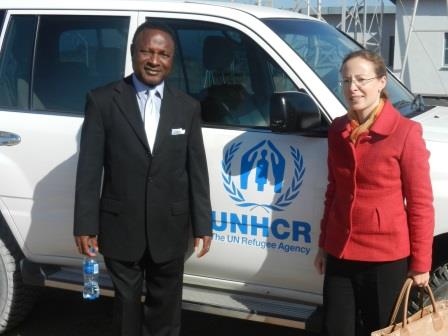20th June 2013 Windhoek, Namibia
Visit to Osire Refugee camp in central Namibia

Today (20 June) is International World Refugee Day 2013 – and I marked the event by travelling out to Osire Refugee Settlement in central Namibia earlier this week.
I was surprised when I arrived in Windhoek to discover that the country had a UN Refugee Agency (UNHCR)-run resettlement camp filled largely by Angolans and Congolese.

Refugees started coming to Namibia in the early 1990s – after Independence – and the country hosted a mix of 25,000 refugees at its height.
This reduced to about 6,000 in recent years. The figure halved again last year after 3,000 Angolan refugees were repatriated home following the declaration of a cessation clause in June 2012; the post war situation in their homeland now being judged conducive for returns.

The camp’s current 2,800 refugees mainly hail from the Kivus in DRC, Rwanda and Burundi – so there has been a big language shift from Portuguese to French in Osire. During a tour of the camp, I was shown its school, hospital, business centre and youth centre.
Refugees were provided with materials to build their own houses, which are made of a mix of mud, corrugated iron and wood.
The settlement is well set out and run. It is a far cry from the tented refugee camps one often associates with TV news stories of mass migrations in conflict zones and after natural disasters.
UNHCR workers confirmed that there is no malnutrition amongst the refugees despite the country’s current severe drought and that living conditions at Osire were in fact better than in some villages elsewhere in Namibia.
The camp boasts a well-established market selling produce grown by refugees in fields adjacent to it. As well as farming projects, UNHCR representatives have also set up sewing and hairdressing projects to help upskill residents and provide them with a modest income.

During this week’s Refugee Day ceremony, guests were treated to a number of cultural songs and dances – and then a full fashion show, highlighting some of the sewing and modelling skills of the camp’s refugee inhabitants, which took many by surprise. How they remained upright in their extra high heels whilst parading in the deep sand of the camp grounds was a marvel in itself.
Namibian officials speaking at the ceremony alluded to their country’s natural inclination to open their arms to needy refugees, which stemmed from their own experiences of being refugees in the region during Namibia’s pre-independence Struggle Days.
UNHCR Country Representative Dr Lawrence Mgbangson noted in his speech that UNHCR was initially given a three year mandate in 1950 but now – 63 years later – the agency is still working in more than 100 countries and protecting thousands of needy people in key conflict zones including Syria, DRC and Sudan.

Now that the southern African region’s troubles are largely over, UNHCR is busy working with the Namibian government to gradually “phase down and phase out” the remaining refugees in Osire by 2014-15. This will enable UNHCR to make a smooth exit from Namibia in order to focus on higher priority refugee issues, including the millions currently being displaced from Syria.
UNHCR is working to strengthen the capacity of the Namibian government and authorities to support the remaining refugees and sort out third country resettlement placements for those that do not want to return home.

Namibia and UNHCR’s success in returning thousands of Angolan refugees home last year helped contribute towards the agency’s ultimate dream of achieving a world without refugees.
What has been achieved in this isolated corner of southern Africa may be a drop in the global refugee ocean but it helps – as, to echo Dr Lawrence’s words in a windy and dusty resettlement camp in central Namibia this week, we must all remember that one refugee in this world remains one too many.
osier is wher I grow up I know every korners of osier I love you
Hi!
may name is Angelino, I deeplly love to have news, about osire refugee camp. where I have also lived for many years has a refugee. A want to take this opportunity to thanks UNHCR for supporting me and my familly. today am back to Angola safe all becouse os your help. may God steel help UNHCR. peace to all refugee.
Greating to Mrs Mariane Young
Angelino
ya I also want to do the same thing dear